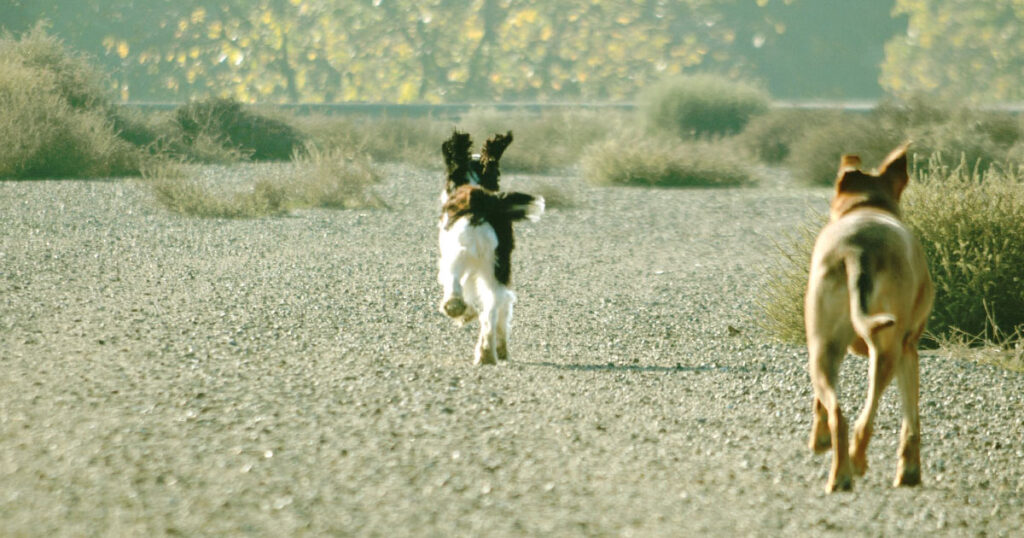
Six days after our friend and former running mate Carmen was released from the hospital following a vicious dog attack in March, my running partner and I went to visit her at her home. She had been in the hospital for eight days, had multiple wounds stitched up, and endured two operations on the tendons and ligaments in her left arm. She’d also been interviewed by all the local newspapers and several TV crews. Her misadventure was quite a story: running alone on back roads on the outskirts of Gijón on a Saturday morning, as she often does, she was attacked by two dogs, both of them pit bull and German shepherd crosses, which had escaped from a farm. The first sank its teeth into her calf. Then when she tried to hit at it with the small pack she wore, the other jumped in. It was impossible to beat them both off. Soon, they overwhelmed her and pulled her down. She fell on her front, not her back, a bit of luck that saved her. A bite to the neck might have killed her. Instead of her face and stomach, the dogs tore at her back, arms, and legs. She probably had 50 stitches, she told me. Two wounds were problematic: the arm because the use of her hand was affected, and her buttock because the bite was so deep that the doctors worried the wound might not close.
At home, a cast from wrist to shoulder kept her left arm immovable so the sutures wouldn’t pull out, which if they did would mean another operation to stitch them back. She greeted us with a grin. She was in her loungewear, but she did go out in the afternoons, shuffling along the street with her husband to the neighborhood terrace for a beer. She’d go crazy otherwise. We had read the newspaper stories, but we got it all over again from the horse’s mouth: how she had slipped off her pack to swing it at the dogs; how while she tried to fend off one, the other jumped at her, biting; how she had lain on the pavement in the middle of the road; how a small delivery van had come along the road very fast toward her, honking; how, as she watched the van come speeding down on her, she had thought she wouldn’t be torn apart by the dogs after all but run over by the vehicle. How with the approach of the van, one dog let go of her to retreat but the other tried to drag her off. All this she told with her usual quick laugh at a good joke.
When the van pulled up, Carmen, her face against the road surface, saw the driver jump out, yelling and waving his arms at the dogs, which withdrew 10 yards. Carmen insisted that the driver lift her off the ground, though he didn’t want to move her. But the dogs were hovering nearby, and to be still prone before them was unthinkable. The man called 112, the emergency number, but he couldn’t say exactly what the location was, so Carmen, who knew the area because she often trained there, had to give the directions. A group of cyclists came along, the police came, and the ambulance came. The dogs hung about, and it took shots fired into the air to scare them off.
The story was soon all over the internet and in the local papers, perhaps because it resonated: a few months earlier, in the province of Zamora, a woman on a solitary walk was attacked and killed by herding dogs. A detail of the attack on Carmen that was not published, and which I learned about from her, was how long the attack had lasted. She knew exactly because of the app on her GPS watch, which registered the precise moment she stopped running and the time lapse between then and when she switched off her watch, after she was back on her feet. Exactly two minutes and 40 seconds had passed. Including the time the driver was gingerly lifting her to her feet.
“Not even three minutes,” I told the pair of students I found myself relating the story to a few weeks later. One of them had visibly tensed at the loud bark of a dog in the hall outside the language school, giving me a good reason to tell the story—I wanted to sympathize with her about her fear of dogs. After describing the attack, the multiple wounds, the honking van, the shaken driver, I then asked how long they thought the attack had lasted. One said maybe 20 minutes. The other agreed. Guess again, I said dramatically. Then I told them. They exchanged wonderfully gratifying looks of horror.
“Was she very very lucky to have fallen on her stomach and very very lucky the van came along so soon after the dogs attacked,” I asked, “or was she very very unlucky to have gone out that morning at the exact time she did, alone, and without the poles she typically trains with?”
That was an interesting question, especially since the topic that day was pessimism versus optimism. Both students had characterized themselves as realist shading into pessimist, and their scores on the quiz on personality had suggested the same. So did their answers to me: they said she was unlucky. Carmen, on the other hand, is always joking, always laughing, always chatting with other runners and always making light of difficulties. In one newspaper interview, she said, “I’m fine. It’s a miracle I’m alive, but this is not going to discourage me. We’ll see when I go out and encounter dogs, but I don’t want this to affect me. I’ll continue training as usual.” To us, two old running mates, she didn’t have to offer assurances. We knew. We too had long before been bitten by the bug.

